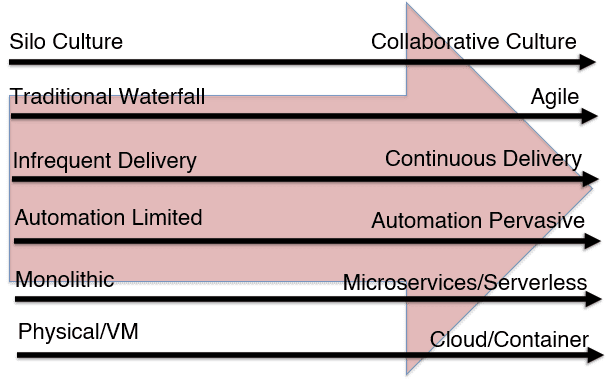The following is a summary of the information covered in the webinar: DevOps for the Salesforce Ecosystem. You can watch the recording here.
Modern IT Transformation
Overwhelmingly, organizations are needing to make a shift in their process and technology landscape to keep up with the speed of business. Many have undergone or are in the midst of this change: moving from traditional waterfall methodology to an Agile mindset, from large, infrequent releases to continuous delivery, and from limited automation to pervasive automation.

This shift includes the adoption of new technologies (e.g., cloud) and architectures (e.g., microservices, containers, APIs). It also applies to the current technologies in your toolchain, including those in the Salesforce Ecosystem.
The goal is to transform IT to be more efficient and deliver high-quality products and services to end users more quickly and cost effectively. DevOps, CI/CD, and heavy automation help achieve these goals.
This way of thinking can be applied to both Salesforce proper and MuleSoft.
Let’s dive into how this looks with the FlexDeploy DevOps platform.
DevOps for the Salesforce Ecosystem
Integrating the Toolchain
The tools you are using today and the tools you are adopting must be integrated. This includes planning tools such as Jira and Azure DevOps Boards, as well as enabling tools like Terraform and Ansible and source control repositories.
FlexDeploy has out-of-the-box support for 100+ open source and commercial tools. This enables you to get off and running quickly and grants you peace of mind that the integration will work.
Automating Your Processes
With the mindset of treating things like source, you can take Salesforce metadata and object types or MuleSoft APIs and code configurations and treat them as code. From there, changes can be packaged during a build and deployed into the desired environments: Dev, Test, and ultimately into the live Production environment.
(This blog walks through the steps to deploy Salesforce apps and metadata objects.)
FlexDeploy supports both Salesforce proper and MuleSoft. These videos provide a quick overview of the solutions:
Establishing Repeatable Processes
Changes can be moved across the lifecycle, from Dev to Test to Prod, very rapidly and consistently because you have created a consistent, streamlined approach to manage and orchestrate releases. The cadence of changes can be hourly, daily, weekly, monthly, or any release cadence.
Gaining Controls and Visibility
Control and governance features in FlexDeploy allow you to configure checks and gates throughout your pipeline. You define the process to meet your needs, and refine the release pipeline as your processes mature. For example, eliminating a manual test step with an automated test or quality check.
At every point, you have visibility into what is running where, when it changed, and more. This information is also stored in reports to be viewed retroactively for continuous improvement and auditing or to proactively gain visibility to your release readiness.
Increasing Employee Productivity and Satisfaction
With manual activities and scripting automated, developers can be more productive and utilize their skillset of developing and problem solving. This drives more business value and greater outcomes.
Administrators, release managers, and many others at the organization benefit from this shift as well. This article explores how DevOps benefits the various roles at an organization.
Watch the Full Webinar
Watch the full webinar to see Flexagon President Dan Goerdt walk through FlexDeploy’s support for the Salesforce Ecosystem.
Want to keep learning? Check out other on-demand and upcoming webinars.




